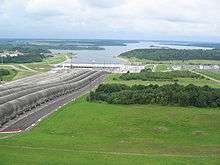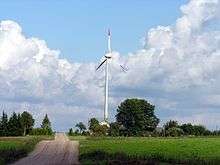Renewable energy in Lithuania
In 2016 Renewable energy in Lithuania constituted 27.9% of the country's overall electricity generation.[1] [2] Previously, the Lithuanian government aimed to generate 23% of total power from renewable resources by 2020, a goal was achieved in 2014 (23.9).


Statistics
Renewable energy in Lithuania by type:[3]
| Type | % |
|---|---|
| Biomass | 82.5 |
| Wind Power | 6.7 |
| Biofuels | 3.9 |
| Hydroelectricity | 2.7 |
| Biogas | 2.2 |
| Waste-to-Energy | 1.5 |
| Solar | 0.4 |
| Geothermal energy | 0.1 |
Biomass
Biomass represents the most common source of renewable energy in Lithuania, with most of the biomass is use being firewood. The amount of energy generated from biomass in Lithuania is the second highest in the EU per capita. It is estimated that in 2020 the country will lead the EU in the quantity of biomass available for biofuel production.
| Country | Per Capita Biofuel Production |
|---|---|
| Lithuania | 0.25 |
| Latvia | 0.23 |
| Denmark | 0.22 |
| France | 0.19 |
| Estonia | 0.18 |
| Hungary | 0.17 |
| Czech Republic | 0.16 |
| Spain | 0.14 |
| Poland | 0.13 |
| Sweden | 0.12 |
| Ireland | 0.12 |
| Greece | 0.09 |
| Austria | 0.09 |
| Germany | 0.08 |
| Bulgaria | 0.08 |
| Romania | 0.07 |
| Italy | 0.06 |
| Slovakia | 0.06 |
| Slovenia | 0.05 |
| United Kingdom | 0.05 |
| Belgium | 0.04 |
| Portugal | 0.04 |
| Netherlands | 0.03 |
| Finland | 0.02 |
| Luxembourg | 0.00 |
| Cyprus | 0.00 |
| Malta | 0.00 |
Biofuel
| Biofuels[5] | ||||||||
|---|---|---|---|---|---|---|---|---|
| Consumption 2005 (GWh) | Consumption 2006 (GWh) | Consumption 2007 (GWh) | ||||||
| Total | Total | Biodiesel | Bioethanol | Total | Biodiesel | Bioethanol | ||
| 97 | 226 | 162 | 64 | 612 | 477 | 135 | ||
Biogas
| Year | 2009 | 2010 | 2011 |
|---|---|---|---|
| Capacity (million m3) | 9.8 | 20.9 | 23.2 |
Hydroelectricity
- Kruonis Pumped Storage Plant, its main purpose is to provide a spinning reserve of the power system, to regulate the load curve of the power system 24 hours a day. Installed capacity of the pumped storage plant: 900 MW (4 units, 225 MW each).
- Kaunas Hydroelectric Power Plant, it supplies about 3% of the electrical demand in Lithuania.[6]
Geothermal energy
- Klaipėda Geothermal Demonstration Plant, the first geothermal heating plant in the Baltic Sea region.[7]
Solar power
Solar power in Lithuania created 2.4 MWh power in 2010.[8] At the start of 2014 Lithuania had capacity of 61 MW of solar power.[9]
Wind power
Installed wind power capacity in Lithuania and generation in recent years is shown in the table below:[10][11][12][13][14]
| Year | 1998-2003 | 2004 | 2005 | 2006 | 2007 | 2008 | 2009 | 2010 | 2011 | 2012 | 2015 | 2016 |
|---|---|---|---|---|---|---|---|---|---|---|---|---|
| Installed (MW) | 0 | 6 | 0 | 42 | 3 | 3 | 37 | 72 | 16 | 46 | - | 79 |
| Capacity (MW) | 0 | 6 | 6 | 48 | 51 | 54 | 91 | 163 | 179 | 225 | 432 | 509 |
See also
- Energy in Lithuania
- Wind power in Lithuania
- Solar power in Lithuania
- Renewable energy by country
References
- "Energetikos statistika" (in Lithuanian). stat.gov.lt. 2012-06-15. Archived from the original on 2012-08-05. Retrieved 2012-06-16.
- [Lithuanian Renewable Energy Promotion Action Plan 2010-2020 years. 2008. Applied research. Vilnius. 215]
- Biofuels barometer 2007 – EurObserv’ER Systèmes solaires Le journal des énergies renouvelables n° 179, s. 63–75, 5/2007
- "Kauno HE modernizavimas" (in Lithuanian). Lietuvos Energija. Archived from the original on 2007-07-22. Retrieved 2008-01-09.
- "Implementation Completion Report". The World Bank. 2005. p. 4. Retrieved 2008-05-04.
- "Energetikos statistika 2010 m. keitėsi šalies kuro ir energijos sąnaudų struktūra" (in Lithuanian). stat.gov.lt. 2011-06-05. Archived from the original on 2012-04-07. Retrieved 2012-06-10.
- Instaliuota gala
- "Wind in power - 2009 European statistics" (pdf). ewea.org. February 2010. Retrieved 2012-06-06.
- "Wind in power - 2010 European statistics" (pdf). ewea.org. February 2011. Retrieved 2012-06-06.
- "Wind in power - 2011 European statistics" (pdf). ewea.org. February 2012. Retrieved 2012-06-06.
- "Wind in power in Europe 1998-2009" (XLS). ewea.org. February 2009. Retrieved 2012-06-06.
External links
![]()